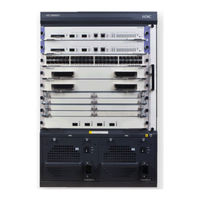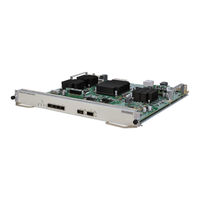H3C SR8800-F Manuals
Manuals and User Guides for H3C SR8800-F. We have 4 H3C SR8800-F manuals available for free PDF download: Configuration Manual, Installation Manual, Faq, Quick Start Manual
H3C SR8800-F Configuration Manual (502 pages)
Comware 7 User Access
Brand: H3C
|
Category: Network Router
|
Size: 3 MB
Table of Contents
-
-
About AAA17
-
-
-
-
-
-
Appendixes98
-
-
DHCP Overview
104-
DHCP Options107
-
-
-
Enabling DHCP150
-
-
-
-
-
Dhcpv6 Overview
186 -
-
-
-
-
-
Prerequisites236
-
Procedure236
-
-
Prerequisites237
-
Procedure237
-
Configuring PPP
246-
About PPP246
-
PPP Protocols246
-
PPP for Ipv4247
-
PPP for Ipv6248
-
-
-
-
Procedure262
-
-
Configuring L2TP
266-
About L2TP266
-
-
-
-
About Pppoe291
-
-
-
-
-
About Portal310
-
Portal System310
-
-
Procedure327
-
-
-
Procedure344
-
-
-
Advertisement
H3C SR8800-F Installation Manual (148 pages)
Brand: H3C
|
Category: Network Router
|
Size: 20 MB
Table of Contents
-
-
-
-
-
-
-
-
Mpus81
-
Overview81
-
CSPEX Cards84
-
CMPE Cards86
-
Subcards87
-
OAA Modules90
-
Overview90
-
Fan Trays92
-
Air Filters93
-
CF Cards93
-
Appendix C Leds
102-
Appendix C Leds103
-
MPU Leds103
-
Card Status Leds106
-
CSPC/SPC Leds108
-
Subcard Leds109
-
OAA Module Leds112
-
-
-
Cable Pinouts121
-
RJ-45 Connector121
-
Cable Type122
-
Pin Assignments123
-
E1 Cable125
-
Optical Fiber128
-
Fiber Connector129
-
Patch Cord129
-
Pigtail Cord129
-
Precautions130
H3C SR8800-F Faq (37 pages)
Brand: H3C
|
Category: Network Router
|
Size: 0 MB
Table of Contents
-
Entries Aged22
-
Scenarios26
-
Interface26
-
IP Routing29
-
Mpls30
-
IP Multicast31
-
Qacl32
-
Approaches34
-
Atm34
-
Command34
Advertisement
H3C SR8800-F Quick Start Manual (21 pages)
High-End Routers
Brand: H3C
|
Category: Network Router
|
Size: 0 MB
Table of Contents
-
Console Port18
Advertisement



